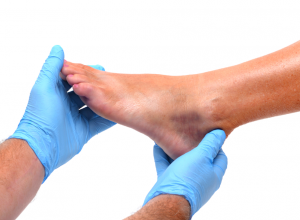
Acute Limb Ischemia
Acute limb ischemia (ALI) refers to a sudden lack of arterial blood flow from the heart to one or more of the body’s limbs. ALI causes arterial insufficiency, meaning there isn’t enough blood supply reaching a limb to give it the cells the oxygen and nutrients they need for survival. Left untreated, acute limb ischemia can lead to gangrene, limb amputation and possibly death.
Symptoms
Symptoms of acute limb ischemia are often called “the six P’s” and consist of:
- Pain
- Paralysis
- Pulselessness
- Pallor (a pale appearance of the skin)
- Paresthesias (a tingly or prickly feeling)
- Poikilothermia (swift changes in temperature)
These six symptoms can quickly lead to gangrene (tissue death) of the limb, so immediate medical attention should be sought upon first experiencing a combination of any of these signs in a hand, arm, leg or foot.
Causes
Acute limb ischemia is generally caused by either embolism (which is usually of cardiac origin) or arterial thrombosis (blood clotting that can be caused by peripheral vascular disease). Other causes may be arterial blockage from cholesterol deposits, arterial spasm or arterial injury. Acute limb ischemia, including ischemic foot, is rarely caused by dissection or trauma.
Though acute limb ischemia can affect patients of all age groups and both genders, it most commonly affects those who smoke and/or have diabetes mellitus. Additionally, most cases of ALI affect those with atherosclerosis issues.
Treatment
Treatment of acute limb ischemia is highly successful as long as a person seeks immediate medical treatment. Delayed treatment beyond six hours can result in permanent disability, amputation of the extremity and even death.
Typical treatment plans include using diagnostic tools like a duplex ultrasonography, computer tomography (CTA) and magnetic resonance angiography (MRA) to help plan revascularization (the restoration of blood to the affected limb). However, CTA and MRA are usually the first options, as duplex ultrasonography isn’t thought to be as precise as the other two treatments.
The diagnosis is then usually followed by emergency embolectomy (removal of the clot or clog causing the issue) using a Fogarty Catheter or a vascular bypass to help route the arterial blood flow around the clot.
In some cases, a patient is unable to undergo surgery. When this happens, the patient may receive chemical thrombolytics like streptokinase, anisterplase, tissue plasminogen activator or urokinase to help break up the clot. Alternatively, he or she may receive mechanical thrombolysis via saline jets or ultrasound waves.
Complications
According to Medscape, limb hypoperfusion (inadequate perfursion of body tissue) can result in systemic acid-base and electrolyte abnormalities that may impair cardiopulmonary and renal function. Furthermore, successful reperfusion may result in highly toxic free radicals being released into the blood stream, which can further compromise a patient experiencing acute limb ischemia.
Notice concerning medical entries:
Articles having medical content shall serve exclusively for the purpose of general information. Such articles are not suitable for any (self-) diagnosis and treatment of individual illnesses and medical indications. In particular, they cannot substitute for the examination, advice, or treatment by a licensed physician or pharmacist. No replies to any individual questions shall be effected through the articles.






